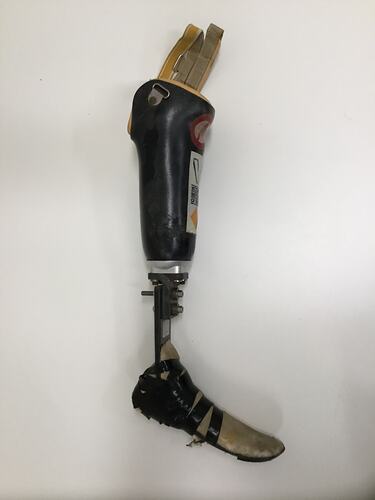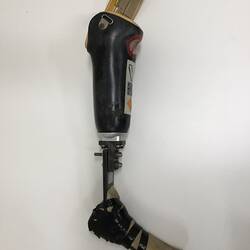Summary
Transtibial prosthesis, comprising an Össur 'Modular III' model Flex-foot carbon-fibre foot prosthesis mounted on cast Orthopaedic Techniques fibreglass socket. The prosthesis and socket were not purchased at the same time.
The Modular III is a version of the original 'Flex-Foot' design, manufactured by Össur, one of the world's largest prosthetics companies, has manufactured these feet since the early 1990s. Champion athlete Don Elgin acquired the foot in 1995 and wore it, attached to a different socket, to the 1996 Atlanta Paralympics. The foam padding and black electrical tape bound to the prosthesis date from this time. He used this foot until 1997. Don attached the foam to the leg to enable him to wear a running shoe on the foot. When he went to the 1996 Paralympics he discovered that other elite runners were not wearing shoes on their prostheses so he abandoned that practice. Images of Don running at the event show him wearing a shoe on his prosthesis.
The socket dates from 1997, and was manufactured by Orthopaedic Techniques, Richmond, Victoria, by prosthetist Martin Vercoe. The donor wore it to the 1998 International Paralympic Committee (IPC) World Championships in Birmingham. This socket is, according to Don, significant because it was one of the first worn in international competition to bear substantial sponsorship materials. In 1998 Don was working for Australia Post and holding a scholarship from the Victorian Institute of Sport. The logos of both organisations are embedded in a layer of fibreglass on the outer surface of the leg, along with the logos of Waves Fitness centre in Moorabbin, where Don trained, and T &J labour hire services, his father-in-law's business.
According to Don, this was the second socket that he had treated in this way, and to the best of his knowledge it was the second that had ever been used to carry advertising in this way. Because he was not ranked in the world top three competitors in any of his events at this time, Don had trouble attracting sponsorship. He therefore pursued unconventional methods to try and attract more support. He says that as a result of this leg and the controversy that it caused the IPC introduced a set of rules governing the size and placement of sponsors logos and other advertising on prostheses.
Physical Description
A 'J' curved carbon fibre prosthetic foot attaches to the socket using two bolts at top. Black in colour. Foot has off-white foam attached with black electrical tape. There are two beige velcro straps at top for securing the prosthesis. Socket is custom made from fibreglass to fit the stump of the wearer. Finished in black, the socket has four cloth logos sealed under the outer, clear, layer of fibreglass. On the front of the leg are the emblems, dating from 1997, of Australia Post, the Victorian Institute of Sport, and Commonwealth Bank. On the left hand side of the leg are the logos of Waves Fitness Centre, and T&J Labour Hire.
More Information
-
Collecting Areas
-
Acquisition Information
Donation from Don Elgin, 25 Jun 2006
-
Date Made
-
Past Owner or User
Don Elgin, Chelsea Heights, Greater Melbourne, Victoria, Australia, 2002
-
Inscriptions
Logos on shin section: T / & / J / LABOUR HIRE / SERVICES PTY. LTD. / PH 580 7444 Waves / Leisure Centre VICTORIAN / INSTITUTE / OF SPORT
-
Model Name or Number
-
Brand Names
-
Classification
-
Category
-
Discipline
-
Type of item
-
Object Dimensions
125 mm (Width), 235 mm (Depth), 590 mm (Height)
Height measurement taken with shin section vertical and does not include straps at top.
-
Keywords
Athletics, Disabilities, Disability Technologies, Sport, Legs



